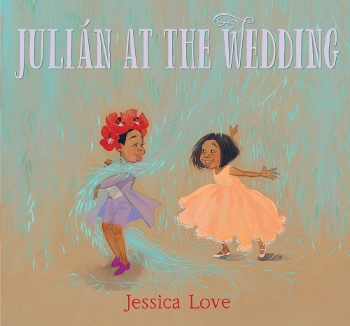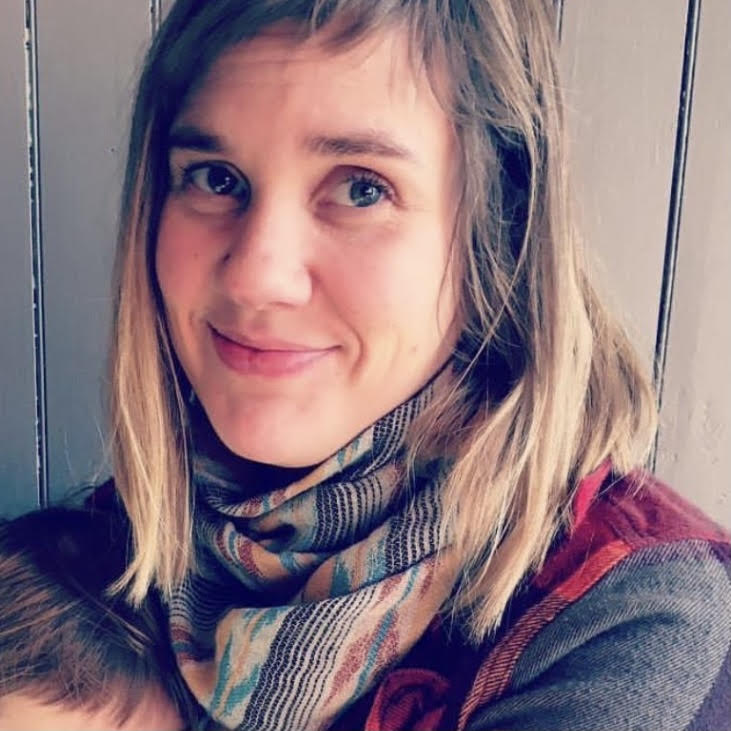We get to meet Julián from 2018's Julián the Mermaid again in Jessica Love’s Julián at the Wedding, and this time we’re welcomed into his larger circle with an invitation to a “party for love,” which is perhaps the best descriptor for a wedding that anyone could conjure — and one that pulls at our deepest parts during a time of profound loneliness for so many of us.
 We first met Julián in 2018, when Jessica Love’s debut picture book, Julián the Mermaid, came into the world — with Love's use of mixed media on brown paper. The protagonist’s emotional trajectory was tangible, evoking for so many what it feels like to crave acceptance without condition. We get to meet Julián again in Love’s follow-up, Julián at the Wedding, and this time we’re welcomed into his larger circle with an invitation to a “party for love,” which is perhaps the best descriptor for a wedding that anyone could conjure — and one that pulls at our deepest parts during a time of profound loneliness for so many of us.
We first met Julián in 2018, when Jessica Love’s debut picture book, Julián the Mermaid, came into the world — with Love's use of mixed media on brown paper. The protagonist’s emotional trajectory was tangible, evoking for so many what it feels like to crave acceptance without condition. We get to meet Julián again in Love’s follow-up, Julián at the Wedding, and this time we’re welcomed into his larger circle with an invitation to a “party for love,” which is perhaps the best descriptor for a wedding that anyone could conjure — and one that pulls at our deepest parts during a time of profound loneliness for so many of us.
Love (whose name can’t possibly be lost on anyone) paints a backdrop for Julián’s next chapter with that familiar radiance and lushness, returning once again to watercolor, gouache, and ink on brown paper. Julián meets a new friend at the wedding, Marisol, and the visual narrative is a perfect dance that encapsulates the breathlessness of young freedom and fresh connection. The illustrations are at once busy and delicate, vibrant and soft, detailed and expansive. Each spread offers a sense of movement and a bit of urgency, which appropriately reflect the book’s emotional charge and the excitement and immediacy that wrap themselves around the possibility of forging a connection with someone new. At the same time, the art warrants a slow, delicate hand; while holding the book, a reader almost feels like they might smudge an illustration if the page is turned too quickly. This is not a book you can flip through casually — it requires every bit of your attention, from the minute you pick it up to the minute you put it down.
Children, like all of us, are meaning-makers, in ways both large and small, and there are many moments in Julián at the Wedding that require readers to confront their own positionality. As the abuelas, on the first page of the book proper, adorn Julián and Marisol with boutonniere and wreath, respectively, we wonder: do they want to wear those? Who asks us to wear the things we wear? How do we feel when we’re wearing them? We can all find parts of ourselves in this narrative, whether it’s in our own search for subjective beauty, or in an unyielding effort toward self-realization and validation.
[Read the Horn Book Magazine review of Julián at the Wedding here]
There are so many treasures to uncover in Julián at the Wedding, from small details (like the tension that builds through eye contact, or the exhale we feel upon seeing Abuela’s shoes come off underneath the dinner table) to large visuals that sweep us up (like the personified weeping mermaid tree, which literally holds and protects the two friends as they move Marisol’s outfit back toward a literal and a more internal type of comfort). In this uncovering lies the magic of Love’s work, and the gift of being able to deepen our own understanding of and adherence to binaries that limit us. These illustrations center queerness, to be sure, and they also center Julián as a complete and evolving presence; he is more confident this time around, but still tender and questioning and playful. Within the visual narrative, though, lies a call to acknowledge the murky landscape revealed when white artists tell Black and Brown stories. Love’s whiteness must be named, especially after having created a second picture book filled entirely with Black and Brown characters. What does it mean for white artists to tell stories that aren’t theirs? Though she can’t claim ownership of Julián, Love certainly created this character with someone else’s lived experience in mind. This ultimately works against her, and, unfortunately, against Julián, too. He should be telling his own story.
Nevertheless, Julián at the Wedding, much like its predecessor, opens a door, inviting us into important moments that feel both communal and highly personal. Love’s work, at the very least, pushes us to question our own beliefs around gender performance, and at most, holds the potential to disrupt some of these constraints and illuminate a connection between what makes us feel good and the inimitable beauty of the small details — a vase overflowing with nasturtiums, a table covered with lace — that make up our everyday worlds.

ALREADY A SUBSCRIBER? LOG IN
We are currently offering this content for free. Sign up now to activate your personal profile, where you can save articles for future viewing.








Add Comment :-
Be the first reader to comment.
Comment Policy:
Comment should not be empty !!!